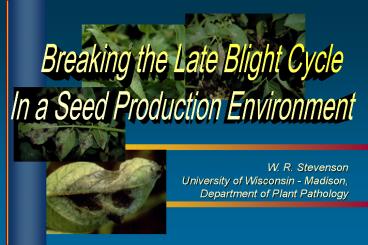potato data slides 1994 - PowerPoint PPT Presentation
1 / 26
Title:
potato data slides 1994
Description:
Breaking the Late Blight Cycle. In a Seed Production Environment. Potato Late Blight ... Breaking The Cycle. W. R. Stevenson, UW-Madison ... – PowerPoint PPT presentation
Number of Views:120
Avg rating:3.0/5.0
Title: potato data slides 1994
1
Breaking the Late Blight Cycle In a Seed
Production Environment
W. R. Stevenson University of Wisconsin -
Madison, Department of Plant Pathology
2
Potato Late Blight
3
Potato Late Blight
4
Potato Late Blight
5
Potato Late Blight
6
Potato Late Blight
7
Why Do We Worry About Late Blight In A Seed Area ?
- Seed potatoes are generally grown in cooler
climates more favorable for late blight
development - Late blight pathogen is wind borne, long
distances - Late blight pathogen is tuber-borne
- Late blight is a community disease
8
Why Do We Worry About Late Blight In A Seed Area ?
- Concerned customer base
- Possible loss of crop certification
- Cost of disease control
- 50 per acre ? 250 per acre
- "Triple bottom line"
- financial viability
- environmental responsibility
- responsibility to society
9
The Late Blight Cycle
- Pathogen arrives in seed area via wind or seed
- Infection of susceptible, unprotected plants
- Before adequate fungicide programs
- Poor or no fungicide coverage
- Long wet and cool period
- Disease spreads rapidly
- Control costs escalate
- Tuber infection
- Pathogen survives winter on tubers
- Repeat the cycle
10
Breaking The Cycle
- Tougher seed standards
- Currently allow 1 seed infection
- Some states force growers to plant only certified
seed - Rejection of seed lots when late blight on
foliage - Would a field be rejected for 1? 10? 100?
1000? lesions per field?? - Can we predict tuber infection on basis of
foliage infection??
11
Potato Late BlightA Little Inoculum Goes a Long
Way
- 1 seedpiece infection
- 10 ft-diameter area killed from 1 infected
seedpiece
10 foot diameter
12
Potato Late BlightA Little Inoculum Goes a Long
Way
- 1 seedpiece infection
- 10 ft-diameter area killed from 1 infected
seedpiece - 25 of the area of the field
13
Breaking The Cycle
- Tougher seed standards
- Currently allow 1 seed infection
- Some states force growers to plant only certified
seed - Rejection of seed lots when late blight on
foliage - Would a field be rejected for 1? 10? 100?
1000? lesions per field?? - Can we predict tuber infection on basis of
foliage infection??
14
Breaking The Cycle
- Rules regarding cull piles
- WI mandatory cull pile destruction by May 20
- Bury
- Grind and spread
- Landfill
- Feed to livestock
15
Breaking The Cycle
- Volunteer potatoes
- Mild winters or heavy early fall snows
- Early season planting of row crops peas, beans,
corn - Lack of effective herbicides
- Are volunteers a public nuisance?
16
Breaking The Cycle
- Seed purchase and handling
- Know the seed grower
- Visit the grower, walk the fields, view the
storages - Ask for field records
- IPM scouts
- Certification inspectors
- Shipping point inspection
17
Breaking The Cycle
- If late blight risk associated with seed -
- Consider treating seed with Tops/MZ/Curzate
Evolve - Consider treating field with protectant fungicide
at emergence - If late blight pathogen confirmed on seed -
- Consider the consequences of planting infected
seed - Increased management costs
- Risk to crop in field and storage
- Community source of late blight
18
Breaking The Cycle
- At emergence (risk of late blight in seed,
volunteers or cull pile) - Consider treatment with protectant fungicide
- At row close or at 18 severity values
- If no late blight, but risk high (18 severity
values) - Protectant spray with chlorothalonil, mancozeb,
metiram - Repeat at 5-7 day interval depending on crop
growth and weather
19
Breaking The Cycle
- If late blight present in area, but not in field
- Treat with cymoxanil plus chlorothalonil,
mancozeb, metiram immediately - Continue at tight interval for three sprays then
protectant alone
20
Breaking The Cycle
- If late blight present in field in pockets
- Disk hot spots with perimeter
- Treat rest of field and adjacent fields with
cymoxanil immediately, and again in 5 days - Then continue with protectant program
21
Breaking The Cycle
- Late blight throughout field
- Destroy field immediately and treat adjacent
fields with famoxate/cymoxanil immediately and
again in 5 days - Continue with protectant program
22
Breaking The Cycle
- Mid Season
- Focus on protectant program that may include
Curzate, Acrobat or Tattoo - Scout fields weekly or even more often
- Careful irrigation to avoid excess
23
Breaking The Cycle
- Late Season
- Focus on protectant program that may include
Acrobat, Tattoo - Apply vine desiccant to protect size of seed
potatoes and to allow at least 3 weeks of dead
vines before harvest - Careful irrigation to avoid excess
24
Summary
- Effective late blight strategy focuses on
- Keeping the fungal pathogen out of the planting
area - Intensive monitoring of every field
- Careful monitoring of weather conditions
- Careful application of fungicide
- Partnership between each and every grower
- Prompt response to local outbreaks
25
(No Transcript)
26
and comments . . .































